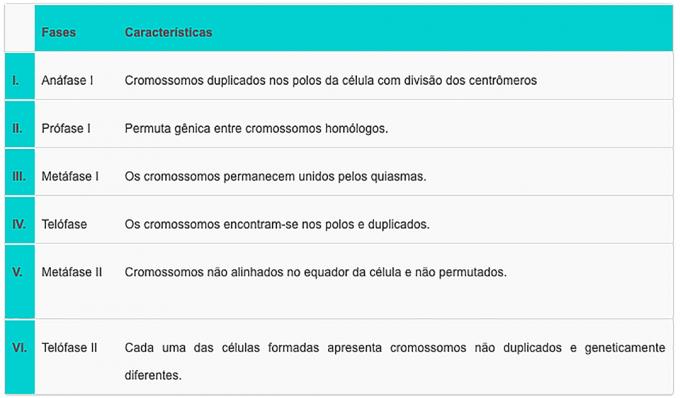
A meiosisis cell divisioncalled reduction division because it reduces the number of chromosomes of the cells causing a diploid cell from origin to four haploid cells.
We prepared a meiosis exercise list so you can test your knowledge of cell division that forms gametes.
see more
Biology teacher fired after class on XX and XY chromosomes;…
Cannabidiol found in common plant in Brazil brings new perspective…
You can consult the template and save this list of exercises in PDF at the end of the post, enjoy!
1) (UNIOESTE) Consider the associations below about the phases of meiosis and their characteristics.
 Determine the alternative whose associations are all correct.
Determine the alternative whose associations are all correct.
a) II, V, VI.
b) II, IV, VI.
c) II, III, VI.
d) I, III, V.
e) I, V, VI.
2) (VUNESP) Regarding the process of cell division, we can state that:
a) Mitosis consists of two successive cell divisions.
b) eggs and sperm are produced by mitotic divisions.
c) during meiosis, permutation or crossing-over does not occur.
3) (ACAFE) The sequence of subphases of prophase I is:
a) leptotene, diplotene, pachytene, zygotene, diakinesis.
b) leptotene, diplotene, pachytene, diakinesis, zygotene.
c) leptotene, zygotene, pachytene, diakinesis, diplotene.
d) leptotene, zygotene, pachytene, diplotene, diakinesis.
e) leptotene, pachytene, zygotene, diplotene, diakinesis.
4) (FAEE) “A dividing cell has paired homologous chromosomes at the cell's equator, with visible chiasms. The next phase will be (I), characterized by (II).”
Mark the alternative that correctly fills spaces I and II respectively.
a) Anaphase I; separation of homologous chromosomes.
b) Telophase I; division of the cytoplasm.
c) Metaphase II; centromere duplication.
d) Prophase II; disintegration of the karyotheque.
e) Prophase I; crossing over occurs.
5) One of the main phenomena that occur in meiosis is permutation, also known as crossing-over. In this process, pieces of homologous chromosomes are exchanged, thus increasing genetic variety.
Knowing that the exchange occurs in prophase I, mark the subphase in which this process occurs.
a) Leptotene.
b) Zygotene.
c) Pachytene.
d) Diplotene.
e) Diakinesis.
6) Mark the incorrect alternative.
a) Prophase I has five stages, they are: leptotene, zygotene, pachytene, diplotene and diakinesis.
b) The term meiosis derives from the Greek word meiosis, which means diminution, and constitutes an allusion to the fact that, in this type of cell division, the number of chromosomes is reduced by half in the daughter cells.
c) Generally speaking, in prophases I and II, chromosome condensation occurs; in metaphases I and II they bind to spindle microtubules and are arranged in the equatorial region of the cell; in anaphases I and II the chromosomes migrate to the opposite poles of the cell; in telophases I and II they decondense and form daughter nuclei at the poles of the dividing cell.
d) Generally, shortly after the first meiotic division is completed, cytokinesis I occurs, resulting in the separation of two daughter cells.
e) In meiosis, two cells are produced that are genetically different from each other and have half the number of chromosomes as the original cell.
7) During the diplotene phase, it is possible to observe certain points where the chromatids are crossed. These points are called:
a) chiasms.
b) bivalent.
c) chromomers.
d) tetrads.
e) chromosomal synapse.
8) (UFJF) An important consequence of meiosis is the generation of genetic diversity. In this process of cell division, the event that generates greater diversity is:
a) the induction of mutations.
b) separation of sister chromatids.
c) the occurrence of permutation (crossing-over).
d) the induction of homozygosity in the formed cells.
e) the random segregation of homologous chromosomes.
9) Mark the alternative that contains, in sequence, all the phases of meiosis I.
a) Prophase I, Metaphase I, Anaphase I, Telophase I.
b) Metaphase I, anaphase I, telophase I, prophase I.
c) Metaphase I, Prophase I, Anaphase I, Telophase I.
d) Prophase I, metaphase I, telophase I, anaphase I.
e) Anaphase I, Telophase I, Anaphase I, Prophase I.
10) In the zygotene phase, it is possible to observe the pairing of homologous chromosomes, which occurs thanks to the formation of a protein structure that forms a central axis and two lateral bars.
The pairing between homologues is called:
a) chiasms.
b) bivalent.
c) chromomers.
d) tetrads.
e) chromosomal synapse.
1 – b
2 – d
3 – d
4 – the
5 – c
6 – and
7 – the
8 – and
9 – the
10 – and
Click here to save the list of exercises about meiosis in PDF!
See too:


